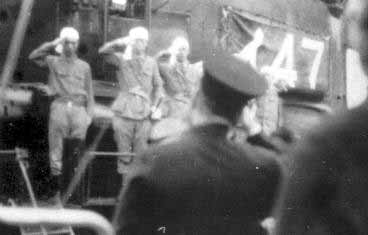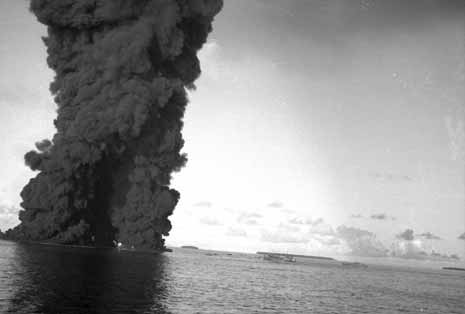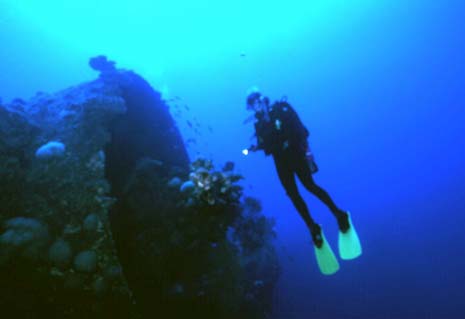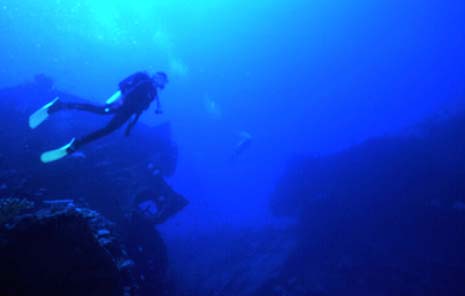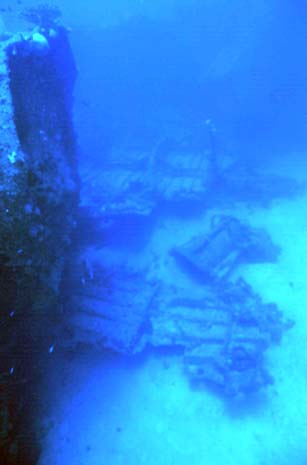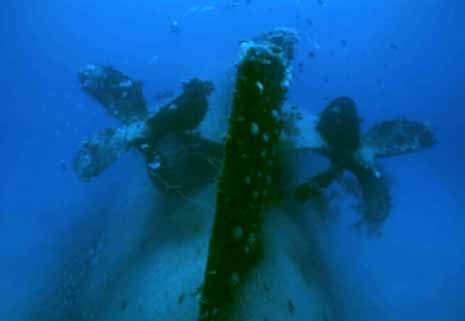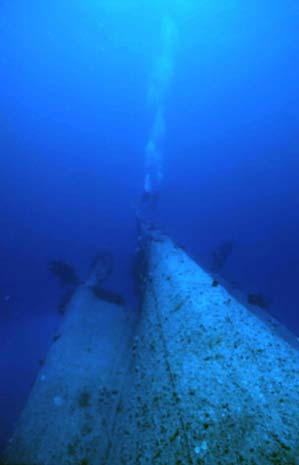Chip Lambert & Pam Lambert
Discovery of USS Mississinewa
Interview with Lewis "Chip" Lambert and Pam Lambert about the discovery of
the fleet oiler USS Mississinewa (AO-59). It was sunk on November 20, 1944
in the Ulithi
Anchorage by a Japanese Kaiten suicide torpedo. The ship
was the only US Navy ship sunk by Kaiten attack alone, and is
the grave site of over
fifty Americans. After searching from March 27 to April 6 2001, the
ship was located - 57 years after its sinking.
What got you and your wife interested in WWII
and diving?
We took a dive group to Palau in 1989. The group went home and Pam and I were going on to Yap. A typhoon
interrupted air travel. Sitting on the verandah of the Palau Pacific
resort consuming adult beverages, we met Dan
Bailey, who, with Dave Buller, had just found the 'Helmet Wreck'.
Many hours later, trips were planned and information exchanged (or maybe
it was the other way around). Next trip, Pam, Dan and I found the Samidare
(Pam's picture at the Samidare site is on the cover of his Palau book).
Many trips latter, including visits to the National Archives and a bulging
personal library, we have never looked back.
My first dive was when a neighbor, in 1961, bought a
Dacor double-hose reg. and tank at the local sporting goods store. It
came with a book that we read at least 2 pages of before putting the
tank on and going down. All I remember was, 'don't hold your breath'.
Some things never change. I almost flunked out of University of Colorado
because I sat through three showings of the movie 'Silent World' when
I was supposed to be taking a final. I became certified during graduate
school in 1967, taught for BSAC during my time in Saudi Arabia. In 1984,
started a dive shop with 4 others in San Jose, CA, and became a PADI
Instructor. I have dived: British Columbia, California coast and inland
lakes, Hawaii, Fiji, Vanuatu, New Caledonia, Truk, Yap, Ulithi, Palau,
New Zealand, Solomon's, Australia, Arabian Gulf, the inland lake and
well of Saudi Arabia, Red Sea, Cypress, Scotland, Maine, Florida, Antigua
and the Galapagos Islands.
My late father started for the Western Pacific, but
the troopship broke down and floundered at sea for a week before being
towed back to Seattle!
Speak about your connection with the veterans of
the ship
The USS Mississinewa (AO-59) was sunk by kaiten torpedo on November 20, 1944.
As we have acquired more knowledge, we have had the
opportunity to share it with Mississinewa veteran groups. These folks have truly become family members. We are in
constant contact with many of them. They share their stories and first
hand information, we try to finalize many of the unsolved events that
they vividly remember from the past. They have had an enormous effect
on my interest and the willingness of both of us to commit large amounts
of money for these trips. They are my heroes. The rewards of these relationships
far exceed any short-term pleasure that might be acquired on a cruise
ship or other vacation destination.
Mike Mair who is writing a book on the Mississinewa's
history. His dad was on board when the ship sunk, and received the
news very despondently. Mike is extremely knowledgeable and was the
primary reason we found the ship. I can only repeat what Mike has told
me about how the crew members are responding. He has first hand interviews.
Elaborate about your first dive on the Mississinewa
Pam describes it as an obsession, I felt
I was just "focused". After spending hundreds of
hours researching the ship and 6 1/2 days looking for it,
when I saw the spike on my bottom finder, I screamed "We
found it", but nobody believed me. I turned the boat
around and we hit it again. Kenneth Wur, one of the Ulithians
helping us, put his mask on and looked below. He claimed he
saw it. I asked him three times what he saw, because we had
a false sighting 2 days earlier. He kept saying, "something,
it must be the ship". At that point, after all the time,
I still didn't believe we had found it.
We donned dive gear. I was the first in and
while waiting, reluctantly put my head under while waiting
for the others to join me. I didn't see anything. Expecting
another disappointment, I sank down about 15' and saw it.
I pegged my ascent rate indicator, yelled
at everybody that it was down there and to follow me. It was
a slow, ethereal descent. I wanted to see everything, but
couldn't believe I was seeing anything. An incredible cloud
of fish illuminated by the noon sun rose out of the crystal
clear water to meet us.
The surreal scene was overwhelming. We had
worked on a dive plan, but after taking pictures of the group,
everybody found their own area of interest. I just kept touching
it to make sure it was real. Fortunately, Pam wasn't quite
as excited, because I had to finish the dive sharing her air.
This is an honest, but I think, an unusual
feeling. After our 1st dive, we went to the island of Elipig,
for lunch and to video our impressions. I was almost afraid
to go back for a second dive because I didn't think it would
still be there. Fortunately, it was.
The ship is upside down, with the top side
buried in the sand. The depth to the ship is 120 feet. The
ship rolled as it sank. The bow went down first and caught
on its port side, which lies on the bottom. The ship continued
to roll to the port, twisting around the huge area on the
starboard side damaged by the kaiten and the explosion in
the #2 and #3 wing tanks that contained aviation gas. The
majority (~85%) of the ship is completely inverted.
The superstructure is buried or compressed
into the sand, which has filled in around the rails. The starboard
rail of the bow comes up to ~85'. The deck is vertical and
there are some open hatches. The stern, with the rudder and
twin screws, is in ~75'.
The Navy was very successful with its anti-fouling
materials, because nothing is growing on the bottom. The water
is the clearest of any wreck sites I've been on (Truk, Palau,
Vanuatu, etc.)
We made a promise
to the veterans and the families of the deceased, that, if
found, we would not penetrate the wreck. It is a grave site
for 50 sailors and it would be the same as going into a cemetery
and digging in the plots for remains. We kept our word and
hope that others have the same respect and sensitivity for
the site. However, of the many interesting things we saw on
the exterior, one piece of plating was incongruous with the
rest. We felt it might be part of the kaiten and others that
have seen the photos, agree.
Did you investigate the other known Kaiten
wrecks in the area?
Not enough time. We found this with about
30 minutes of search time remaining before we ended the trip.
Fortunately, PMA rearranged the flight schedule so we could
have the extra day of searching. Also, the island ran out
of gas. Everybody pooled what was left (they couldn't go out
fishing) and gave it to us so we could continue the search.
Any other upcoming trips or dive plans?
We are going back to Palau in the fall. We found a number
of sites that are potential grave sites that may get more investigation
from CILHI (Central Identification Laboratory Hawaii)
Thank you, Mr. Lambert and congratulations on your
discovery
|
